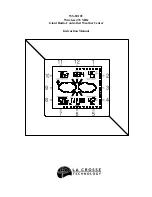
Channel scanning [SCAN]
Channel scanning searches for signals on the selected frequency band. Make sure that the
squelch is closed since this function does not work with an open squelch.
To start/stop the scan function, push the scan button (4) [
SCAN
] briefly. The channels of the
current frequency band are searched in consecutive order. The scan symbol
SC
appears on
the LCD screen (1). Once a signal is detected, the scan function stops and the symbol
SC
in
the display will disappear.
To stop scanning before a signal has been found, press the scan button (8) [
SCAN
] once again.
Keylock
[
F/
]
Upon acitivated keylock function, all keys and functions, except for the PTT key (16) and
transmission, are blocked. To activated the function hold the keylock button [
F/
] until the
key symbol appears in the LCD (1).
To deactivate the key lock function press the key again.
Dual watch function [DW]
This function allows you to scan two channels for signals. Before activating this function make
sure that the squelch is closed.
Select the first channel to be scanned with the rotary channel switch (12) or the Up/Down
keys (17) [UP] and (18) [DOWN]. Then, briefly press the dual watch key (6) [
DW
]. The dual
watch symbol
DW
appears in the LCD (1) and the channel no. starts blinking.
Now, set the second channel to be monitored and press the dual watch key (6) [
DW
] again.
The radio will toggle between the two set channels until a signal is detected.
To stop the dual watch function, press the dual watch key [
DW
] (6 again.
LCD background illumination [LCR]
Turn the LCD background light either off or switched it between 7 colors by pressing the bak-
kground illumination key [
LCR
] (7).
Priority Channel 9/19 [9/19]
The MX-10 contains the priority channels 9 and 19. To toggle between the priority channels 9, 19
and the actual channel, use the priority channel key [
9/19
] (8).
Memory Channels
[
MEM
]
The MX-10 allows to store and recall a maximum of 10 channels of the selected frequency band
on a separate memory bank.
Programming of
MEM
channels:
1. Select the channel/frequency to be stored.
2. Activated the programming mode by pressing the memory key
MEM
(9).
The symbol
ME
will blink in the LCD (1).
3. Confirm the programming by pressing the
MEM
key (9).
Recall of
MEM
channels:
1. Press the key
F
(5) first and then the key
MEM
(9). The symbol
RD
appears in the LCD.
2. Select the wanted
MEM
channel (1-10) with the rotary channel selector (12).
3. Confirm the selection by pressing the
MEM
key (9). The symbol M appears in the LCD.
English
English
16
17
Operation of the TEAM MX-10
On/Off [OFF/VOL]
Before turning the radio on, set the squelch control (13) [
SQ
] to the lowest level by turning the
switch counterclockwise to the left.
Turn on the radio by turning the volume control (10) [
OFF/VOL
] clockwise. The LC display (1)
will illuminate. Adjust the receiver sound with the volume control to the desired level.
All settings are stored after the unit is switched off, as long as the power supply is not disrupted.
Channel selection
The channels of the selected frequency band can be selected by pushing the channel selec-
tor keys (17) [
UP
] and (18) [
DOWN
] at the microphone or with the rotary channel selector (12)
located on the front panel of the radio.
The channel number and frequency are displayed on the LCD (1).
No channel selection is possible while the radio is in TX mode. The channels are selected in
a consecutive order.
For communication with another CB radio, both transceivers must have selected the same
channel and the same modulation mode.
Transmit
To transmit, hold the PTT key (16) of the microphone. The RX/TX control LED (14) will light red
and the bar meter at the bottom of the display shows the relative transmit signal strength. For
best quality, speak at an average volume level, at a distance of 2-4 inches into the microphone
(19). Speaking too loudly will cause distortions and will make the signal difficult to understand.
While in transmit mode, no key entry is possible and the receiver is muted. To stop transmission,
release the PTT key (16) and the radio will revert to receive mode automatically.
Squelch [ASQ/SQ]
The strong background noise, which occurs always on free channels, can be suppressed by
the squelch function. The MX-10 has a manual squelch [
SQ
] (13) and an automatic squelch
[
ASQ
] available.
By turning the inner ring of the twin-rotary-selector clockwise, you increase the manual
squelch level gradually. It will increasingly suppress stronger interfering signals, as well as
weak stations.
The automatic squelch
ASQ
is activated by pushing the ASQ key [
ASQ
] (2). The squelch
level is fixed at a mean value. The symbol
ASQ
is visible on the LCD (1).
Mode selection [Mode]
The MX-10 operates in amplitude (AM) and frequency modulation (FM). Please note, that the fre-
quency norm EC of the radio version MX-10 Full Multi Norm, operates in FM only.
If the unit accepts the modulation type AM on the actual channel, you can toggle between AM
and FM by pressing the mode key (3)
[Mode]
.
The selected mode (AM/FM) is shown in the LCD.
With the frequency norm
UK
, which operates in FM only, you toggle between the EC and the
UK band remaining on FM.
manual_MX-10_v1-7:RoadCOM manual.qxd 12/17/2014 8:45 AM Page 16










































